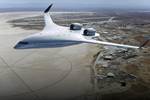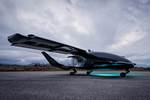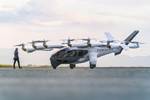Vertical Aerospace eVTOL prototype goes down during uncrewed test flight
The U.K. company has confirmed the Aug. 9 accident that resulted in significant aircraft damage and potential setbacks.
On Aug. 9, Vertical Aerospace (London, U.K.) performed an uncrewed test flight of its VX4 prototype electric vertical takeoff and landing (eVTOL) aircraft at Cotswold Airport. According to several news platforms, at an altitude of about 20 feet, the prototype’s flight resulted in a crash incident, and photos circulating on social media appear to show significant damage to the prototype’s starboard wing. The company confirmed that the aircraft was remotely piloted and there were no injuries.
According to Bloomberg, the company is reportedly pausing flight testing until regulators complete an investigation. Flying Magazine says that Vertical had “anticipated the start of full-scale crewed flight tests in the coming days after what it dubbed a successful completion of the remote phase.” What this might mean for the company’s timeline as it pushes toward multi-region type certification and approximately 1,400 conditional pre-orders is as of yet unclear. New Atlas notes that, earlier this year, the company had already pushed its expected commercial debut back from 2025 to 2026.
In an SEC filing on the crash, Vertical Aerospace says “Our flight test program is designed to establish the limits of the aircraft’s performance, and the incident occurred during an uncrewed test of the aircraft’s maneuverability during a motor failure test scenario, which is a key requirement to progress to crewed operations.”
Despite these trials and tribulations, the U.K. company has still made “great strides” in its flight test program this year. In conducting the VX4’s first untethered flights, a shareholder letter cites, “the aircraft lifted, hovered, flew and landed all by the thrust of its electric propulsion system and powered only by Vertical’s proprietary battery packs.” The prototype aircraft has also carried out 18 takeoffs and landings, and reached its target thrustborne speed of 40 knots (70 kilometers per hour), per Vertical Magazine.
The shareholder letter also updated investors on a second VX4 prototype, currently in development at partner GKN’s Global Technology Facility. The second demonstrator is expected to have “greater capabilities than our first prototype, including improved range and higher performance, particularly in hover.”
Related Content
-
Infinite Composites: Type V tanks for space, hydrogen, automotive and more
After a decade of proving its linerless, weight-saving composite tanks with NASA and more than 30 aerospace companies, this CryoSphere pioneer is scaling for growth in commercial space and sustainable transportation on Earth.
-
Lilium launches M&A process, targets eVTOL program continuation
Despite court-approved insolvency filings and beginning first investor briefings, Lilium remains fully focused on re-emerging following restructuring, setting its sights on fresh investment to support the Lilium Jet.
-
Composites end markets: Pressure vessels (2024)
The market for pressure vessels used to store zero-emission fuels is rapidly growing, with ongoing developments and commercialization of Type 3, 4 and 5 tanks.
















